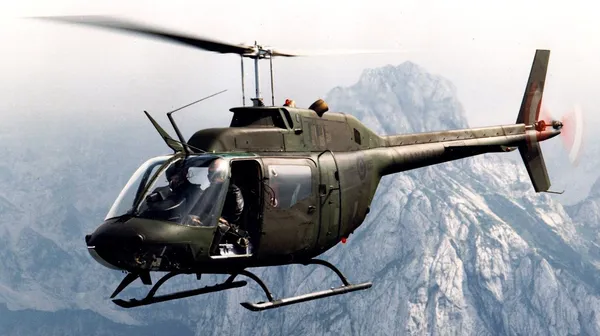Bell CH-136 Kiowa

Bell CH-136 Kiowa (Serial No. 1362--), No. 444 Sqn, 4 CMBG, Germany.
The OH-58A Kiowa is a 4-place observation helicopter. The Kiowa has two-place pilot seating, although the controls in the left seat are designed to be removed to carry a passenger up front. A total of 74 OH-58A helicopters were delivered to the Canadian Armed Forces between 1971 and 1972 as a Light Observation Helicopter (LOH), performing duties such as reconnaissance, command and liaison or artillery fire direction. The CAF re-designated them as the CH-136 Kiowa. Although similar in appearance to the trainer Bell CH-139 Jet Ranger, major differences between the two helicopters include the main rotor blades and dynamic components. The CH-136 was powered by a C-18 engine and the CH-139 was powered by a C-20 engine. Harold Skaarup web page
 CH-136 Kiowa - Kestrel Publications
CH-136 Kiowa - Kestrel Publications
CASPIR Aircraft Groups:
RCAF On Strength (74), Canadian Aircraft Losses (5)Kiowa 136258
Ex US Army OH-58A-BF 71-20923. Category A damage in a crash at Findlay Lake, Quebec on 12 or 13 June 1985. The helicopter was on a night navigation exercise, when three distress radio calls totalling 12 seconds in duration were heard alluding to an undetermined control problem. The helo crashed into the lake. With 427 (Tac Hel) Sqn at CFB Petawawa, ON at that time. Major R.E. Connell and Sgt. H.A. Anderson were both killed in the crash. After an extensive technical investigation, the cause of the accident was traced to an a/c component (free-wheeling unit) failure that effectively disconnected the engine from the drive train but with no indication to the crew of the problem.
SOS: 17 May 1989 - Category “A” write-off
1972-08-09 Taken on Strength 2019-08-20
1989-05-17 Struck off Strength Written off after crash, see comments. 2019-08-20






 Canadian Virtual War Memorial
Canadian Virtual War Memorial Alliston, Ontario
Alliston, Ontario
 Wikipedia Kiowa helicopter
Wikipedia Kiowa helicopter Harold A Skaarup Web Page
Harold A Skaarup Web Page

